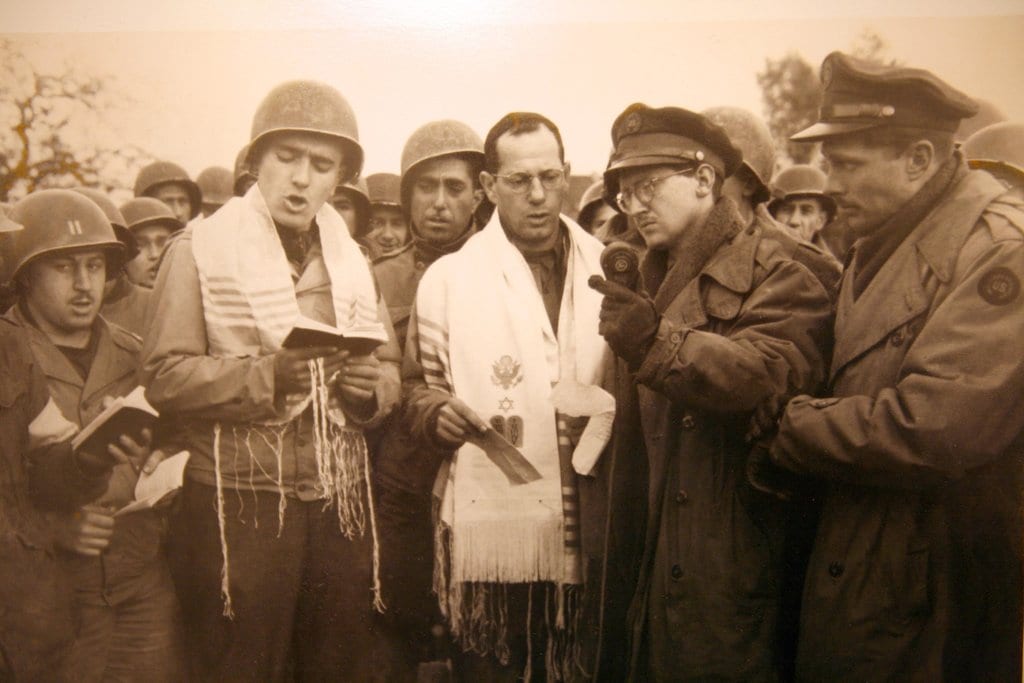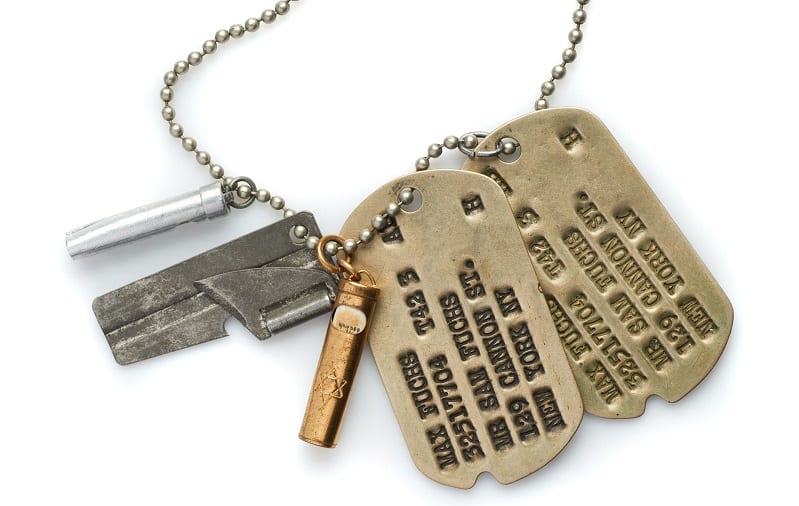For over 50 years, a framed photograph decorated a wall in the Upper West Side apartment of Max Fuchs and his wife Naomi in New York. The photograph shows an American soldier draped in a tallit – prayer shawl – who is praying before a group of Allied Forces soldiers, standing in the middle of a desolate field across from the ruins of an old synagogue. The photograph also shows an NBC correspondent holding a microphone in front of the solider, with black clouds of war peeping out from behind him.
When Max Fuchs, the soldier in the picture, was asked by his daughters to tell them about the photograph, he would find all sorts of excuses not to do so, just like he would try and keep them from feeling the shrapnel in his chest – a ‘souvenir’ from the historic D-Day invasion of Normandy by Allied forces.
In the history of the free world, the day of the Normandy invasion was the day on which the stars started to align themselves for the Allies in their war against the Nazis. But in Max Fuchs’s own history book, it was a traumatic day. Max served in the First Infantry Division that landed on Omaha Beach – the bloodiest sector of the campaign. “The sights were horrific,” he would later tell the New York Times. “Bodies were flying in the air, bullets were whistling next to your ear, and scores of corpses were strewn on the sand.”

After the war, the horrific sights kept Max company every night, and for many years he suffered chronic nightmares that made his life miserable. Max did everything in his power to repress the memory of the day of the invasion, which explains why he refused to talk about the war with his daughters. It’s also why he chose to downplay the moving story hidden behind the historic photograph that decorated the living room in his apartment.
Mordechai (Max) Fuchs was born in Rzeszow, Poland on February 10, 1922, a son of Shaya and Tisha Fuchs. In 1934, a year after Hitler came to power and the persecution of the Jews became worse with every passing day, Max’s parents emigrated to the United States. They settled in the Lower East Side, the New York womb from which American Jewry emerged.
Max, who was 12 when he entered the gates of Ellis Island, was drawn to cantorial music from an early age. He would stand in front of the cantor’s lectern in the synagogue so he could learn the fundamentals of religious singing from the source. And then came the war. At the age of 22, while preparing for his studies at cantorial school, Max was drafted into the army and assigned to the U.S. First Infantry Division. A few weeks later, he found himself in the killing fields of Normandy, where he incurred shrapnel wounds in his stomach and chest. They did not, however, prevent him from continuing to fight with his division comrades.

About four months after the Normandy invasion, Max’s division captured Aachen, the westernmost city in Germany and the first to fall to the American forces. Even though the Third Reich was already in a state of collapse, the Wehrmacht troops continued to wage a bloody battle that took a heavy toll from the Americans.
And then, in the midst of the deep darkness with the end of the fighting close at hand, Max and 50 other Jewish soldiers from his division found themselves looking at the ruins of an old synagogue. Built in Aachen in 1862, it was totally destroyed on Kristallnacht – the Night of the Broken Glass. As luck would have it, an NBC crew was in the city at the time.
“We are now bringing you a special broadcast of historical significance,” announced James Cassidy, the radio reporter, with an excited voice. “This is the first public Jewish prayer service that has been broadcast from Germany since the beginning of Hitler’s rule.” Thus, while reverberations of blasts could still be heard in the background, Max started praying spontaneously, standing in front of the ruins of the old synagogue in Aachen, on the liberated soil of Germany.

He chose two well-known hymns – “Ein Keloheinu” and “Igdal Elokim Hai” – because he assumed that his comrades knew them by heart. Max would later describe what was going through his head and the heads of those Jewish soldiers in the liberation army of the Allied forces, who already knew about the atrocities in the East as they sang the verse: “In His abundant kindness, G-d will revive the dead / Blessed for evermore be His glorious name.”
“All of us had tears in our eyes,” he recalled. “Most of the members of my family in Poland were killed in the Holocaust. I looked at my friends, the Jewish soldiers who had gathered in the desolate field across from the old synagogue. All of them, without exception, had lost at least one relative who had choked to death in the gas chambers or had been murdered in the death camps. There was a great deal of joy there, but also a lot of rage.”
“The prayer service in Aachen” – as it was later called – was an emotional and especially symbolic moment of elation, which reached the ears of millions of Americans and Jews across the globe. And October 29, 1944, the day on which the service was held, became a meaningful date in the history of NBC.
Following the war, Max Fuchs became a sought-after cantor in New York’s Jewish community, while making his living in the diamond polishing industry. Time elapsed and the prayer service in Aachen was forgotten. As mentioned above, Max, who suffered from nightmares due to that cursed day in Normandy, preferred to leave the past behind him. But then one day his daughter, Esther, read an interview with James Cassidy, the reporter who recorded the prayer service. He spoke about the moving event that he covered in Aachen towards the end of World War II. Esther immediately asked her father if the framed photograph in their apartment had something to do with the interview. “Yes, it is of the prayer service that was broadcast on the radio,” he answered nonchalantly.
Esther convinced her father to go public with the story and tell the world that he was the cantor-soldier who led the famous prayer service in Aachen. But Max preferred to remain anonymous. Only in 2009, when he was already 87 years old, did Max agree to a request made by the American Jewish Committee (AJC) that he go back to that day in 1944 and tell his story. It was the first time in his life that he shared his experiences from that historic day.
Max Fuchs died in June 2018 at the age of 96, exactly 74 years after the Normandy invasion. At the new Museum of the Jewish People that is scheduled to open soon, the dog tag that was issued to him as a soldier in the First Infantry Division of the Allied forces will be on display, alongside his story.